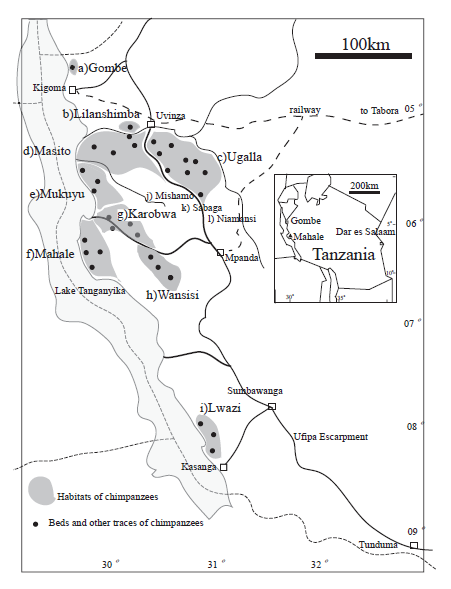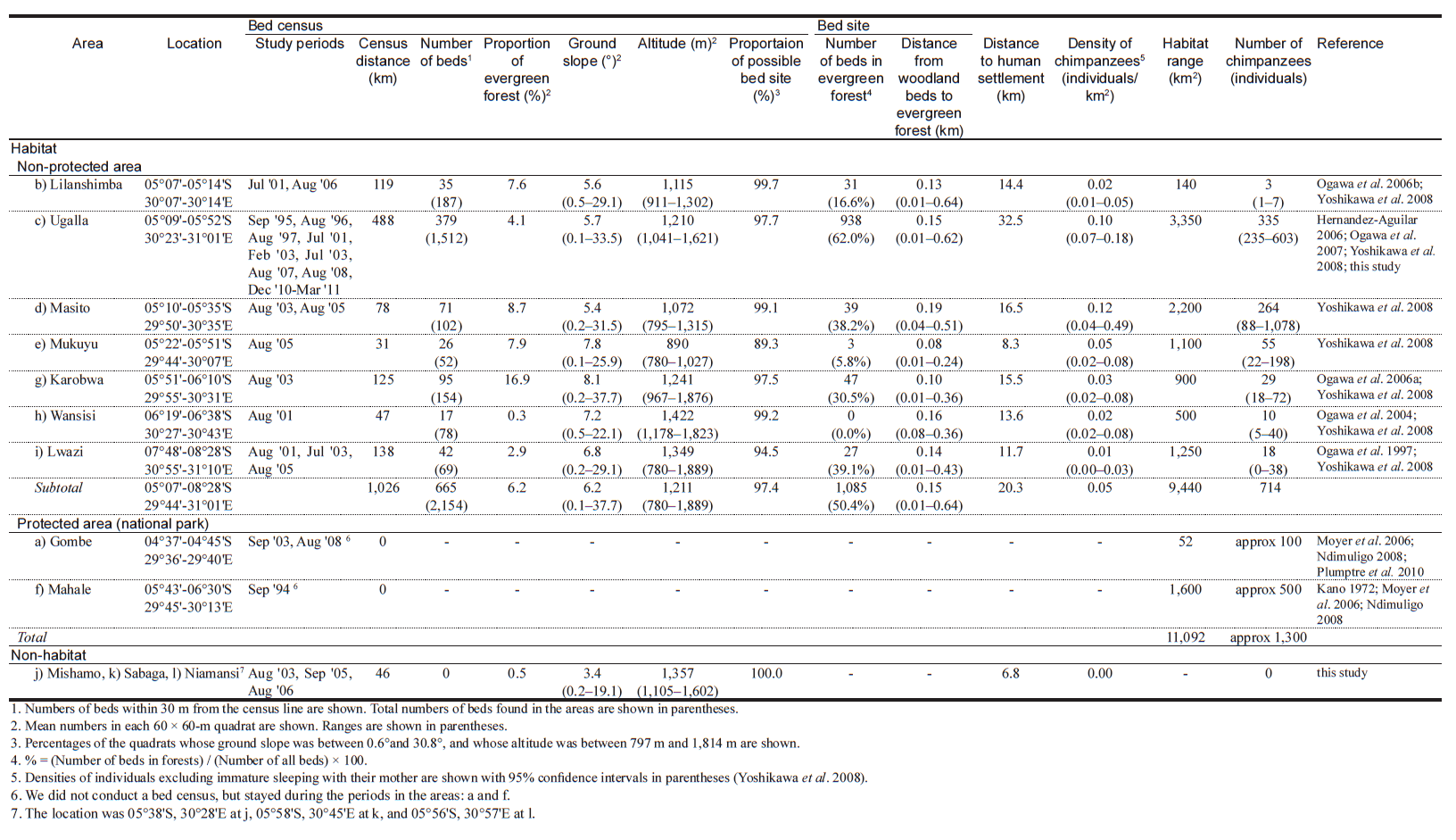|
<ARTICLE>
The Population and Habitat Preferences of Chimpanzees in Non–Protected Areas of Tanzania
Hideshi Ogawa1, Midori Yoshikawa2
& Gen'ichi Idani3
1. School of International Liberal Studies, Chukyo University, Japan 2. United Graduate School of Agricultural Science, Tokyo University of Agriculture and Technology, Japan 3. Wildlife Research Center, Kyoto University, Japan INTRODUCTION Tanzania is the most eastern region of the distribution of eastern chimpanzees (Pan troglodytes schweinfurthii) (Kano 1972). According to Kano's survey in 1965–67 (Kano 1972), chimpanzees inhabited the eastern shore of Lake Tanganyika: a) Gombe (Gombe National Park), b) Lilanshimba, c) Ugalla, d) Masito, e) Mukuyu, f) Mahale (Mahale Mountains National Park), g) Karobwa, and h) Wansisi. In addition, Ogawa and others (1997) found the most southern chimpanzee population in i) Lwazi in 1996 (Figure 1). The geographical distribution of chimpanzee beds (Yoshikawa et al. 2008) and DNA variation (Inoue et al. 2013) indicate that the chimpanzee population is continuous in c–h areas. This means that there are four local populations of chimpanzees in Tanzania: a) Gombe, b) Lilanshimba, so called “Greater Mahale” composed of c–h areas, and i) Lwazi, as well as an introduced population on Rubondo Island in Lake Victoria. Although chimpanzees still inhabit all areas in which they were found in 1960s (Kano 1972; Ogawa et al. 1997, 2004, 2006a, 2006b, 2007; Hernandez–Aguilar 2006; Moyer et al. 2006; Yoshikawa et al. 2008; Ndimuligo 2008; Plumptre et al. 2010), the population density of chimpanzees in nonprotected areas has been significantly reduced from 1960s to 2000s (Yoshikawa et al. 2008). Proper conservational planning is essential to protect chimpanzees (Plumptre et al. 2010). However, chimpanzees in such areas have been much less studied than those in two national parks, a) Gombe and f) Mahale. Therefore, in addition to our extensive field surveys in 1994–2008 (Ogawa et al. 1997, 2004, 2006a, 2006b, 2007; Yoshikawa et al. 2008) and estimation of population densities of chimpanzees (Yoshikawa et al. 2008), we conducted further surveys in 2010–2011 and GIS analyses of chimpanzee habitats in non–protected areas of Tanzania. 
Figure 1. Distribution of chimpanzees in Tanzania. METHODS From 1994 to 2011, we conducted transect bed censuses in all chimpanzee habitats out of national parks: b, c, d, e, g, h, and i, (Ogawa et al. 1997, 2004, 2006a, 2006b, 2007; Yoshikawa et al. 2008) (Figure 1, Table 1). As a control, we conducted bed censuses at j) Mishamo, k) Sabaga, and l) Niamansi in non–habitats of chimpanzees (Figure 1, Table 1). We usually made a round trip from our base camp along the river to the top of a hill and walked on not only traditional paths, but also paths of wild animals and off–path. When we found a chimpanzee bed, we recorded location of the bed using GPS, vegetation of the bed site, and perpendicular distance between the bed and the census line. We chose the census lines whose tracks had been recorded by GPS and/or on 1/50,000 maps, and plotted the census lines on a vegetation map using ERDAS Imagine (Leica Geosystems GIS & Mapping) based on satellite images (ETM+). We then defined a census belt of 60 m width centered on the census line. This width was used, because the detection rate of a chimpanzee bed was constant within 30 m from the census lines. We further divided all of the census belts and defined 60 × 60–m quadrats along the census line. We then calculated (1) proportion of the area covered by evergreen forests, (2) average ground slope, and (3) average altitude in each quadrat using a 90 m SRTM digital elevation model. Using ArcGIS (ArcView 9.3.1) (ESRI), we calculated the distance between each bed cluster and the nearest evergreen forest with area ≥ 1 ha, and the distance between each study site and the nearest edge of the nearest human settlement with area approximately ≥ 10 ha. RESULTS For GIS analyses, we used a total of 1,026 km census lines in chimpanzee habitats and 46 km in non–habitats, yielding 17,845 60 × 60–m quadrats along the census lines (Table 1). The area was occupied by savanna woodlands (86.9%), evergreen forests (5.9%), and others such as grasslands, bamboo thickets, cultivated fields, and human settlements (7.2%). Table 1. Environments of chimpanzee habitats in Tanzania. 
In chimpanzee habitats, there were 665 beds in 186 quadrats, while there were no beds in 17,659 quadrats. Evergreen forests occupied more area, 25.0 ± 35.5% (mean ± SD) (range: 0–100), in the quadrats with beds than in the quadrats without beds, 5.7 ± 18.8% (0–100) (Figure 2(1), Mann–Whitney U test, n1 = 186, n2 = 17,659, z = 12.6, p < 0.05). The slope of the ground was steeper, 10.1 ± 7.1° (0.6–30.8), in the quadrats with beds than the quadrats without beds, 6.5 ± 22.8° (0.1–37.7) (Figure 2(2), z = 8.2, p < 0.05). The difference was not significant between the altitude in the quadrats with beds, 1,217 ± 154.8 m (797–1,814), and those in the quadrats without beds, 1,216 ± 182.0 m (780–1,876) (Figure 2(3), z = 1.5, ns.). 
Figure 2. Conditions in quadrats containing chimpanzee beds in Tanzania. (1) Percentage of evergreen forest area, (2) slope of the ground, and (3) altitude are compared between 60~60–m quadrats containing chimpanzee beds and quadrats without beds. With beds: quadrats containing beds. Without beds: quadrats without beds. Area: b=Lilanshimba, c=Ugalla, d=Masito, e=Mukuyu, g=Karobwa, h=Wansisi, i=Lwazi, N=non–habitat: j) Mishamo, k) Sabaga, and l) Niamansi. The ground slope and altitude of all quadrats with beds were between 0.6° and 30.8°, and between 797 m and 1,814 m. If we regard such quadrats as possible bed sites of chimpanzees, the possible bed sites were 97.4% in chimpanzee habitats and 100% in non–habitats (Table 1). We recorded a total of 2,154 beds within and out of 30m from the census lines. Chimpanzees made 1,085 beds (50.4%) in forests, 1,020 beds (47.3%) in woodlands, and 49 beds (2.3%) in mixed vegetations (Table 1). Beds in woodlands were 0.15 km (0.01–0.64) from the nearest forest (Table 1). The population density of chimpanzees was positively correlated with the proportion of forest in the area (Table 1, Kendall rank correlation test, n = 10: b–e, g–l areas, τ = 0.58, z = 2.3, p < 0.05), and with the distance between the area and the nearest human settlement (Table 1, τ = 0.71, z = 2.9, p < 0.05). DISCUSSION Most of chimpanzee habitats in Tanzania are savanna woodlands (locally called “miombo” woodlands) dominated by deciduous trees of Brachystegia and Julbernardia with small proportion of evergreen riverine forests (Kano 1972). However, 47.3% of beds were in forests and all beds were within 0.64 km from a forest. In addition, the quadrats with chimpanzee beds had a greater proportion of forest than the quadrats without beds. Evergreen forests are indispensable for chimpanzees to make beds especially during the dry season, when most woodland trees lose their leaves (Hernandez–Aguilar 2006; Ogawa et al. 2007). In addition, forests provide chimpanzees with safe sleeping sites. Because forests have fewer grasses and more trees than woodlands, carnivores such as lions (Panthera leo) and hyenas (Crocuta crocuta) are not able to hide themselves for hunting, and chimpanzees can more easily escape into trees (Hernandez–Aguilar 2006). In addition to forests, hilly areas are also critical for chimpanzees in Tanzania, as they prefer making beds in steep slopes (Kano 1972; Hernandez–Aguilar 2006; Ogawa et al. 2007). As a result, chimpanzee habitats in Tanzania had many evergreen forests and hilly areas. However, the quality of chimpanzee habitats has become worse over time, caused by habitat destruction for cultivation, firewood, charcoal, and commercial use of timbers (Ogawa et al. 1997, 2004, 2006a, 2006b, 2007). The population density of chimpanzees shows that the number of chimpanzees outside national parks in Tanzania has been reduced from approximately 1,300 (Kano 1972) to 700 (Yoshikawa et al. 2008) during the last 40 years. Even including 100 chimpanzees in a) Gombe and its surrounding area (Moyer et al. 2006; Ndimuligo 2008; Plumptre et al. 2010) and 500 chimpanzees in f) Mahale (Kano 1972; Moyer et al. 2006; Plumptre et al. 2010), the total number of chimpanzees in Tanzania may be no more than 1,300 individuals. Although another survey estimated that 2,800 chimpanzees inhabited Tanzania (Moyer et al. 2006; Plumptre et al. 2010), both surveys showed that more than half of all Tanzanian chimpanzees inhabited non–protected areas. The estimated population of chimpanzees in Tanzania ranges from 1,300 to 2,800. However, similar methods of bed censuses in 1960s (Kano 1972) and 2000s (Yoshikawa et al. 2008) indicate that the population of chimpanzees in non–protected areas of Tanzania has been remarkably reduced. A huge continuous habitat, Greater Mahale, is precious property of Tanzania. In e) Mukuyu and g) Karobwa, however, people originally from Burundi set many snares around the Mishamo settlement. Such poachers actually killed chimpanzees in these areas (Ogawa et al. 2006a). In b) Lilanshimba, the Lugufu settlement for Congolese refugees was established within chimpanzee habitat in 1997, and cultivation and poaching by these refugees have reduced chimpanzees (Ogawa et al. 2006b). Small isolated populations in b) Lilanshimba and i) Lwazi may be faced with extinction. It is urgently necessary to protect chimpanzees in these two areas, as well as chimpanzees in Greater Mahale. We found that the population density of chimpanzees is lower in areas close to human settlements. To make matters worse, more and more immigrant farmers cultivated fields except for steep hills in e) Mukuyu and g) Karobwa, and h) Wansisi (Ogawa et al. 2004, 2006a). Such haphazard deforestation reduces chimpanzee habitats and does not necessarily benefit future generations of Tanzanian people. It is necessary to adopt sustainable management of trees and other natural resources. Effective conservation plans are possible, because chimpanzees prefer hilly areas which are not suitable for cultivation. Especially, c) Ugalla and d) Masito still have habitats where only a few local people temporally visit. In collaboration with researchers, the Tanzanian government has to make and conduct proper conservation planning to protect chimpanzees and their habitats in Tanzania. ACKNOWLEDGEMENTS We are grateful to: T Kano, HY Kayumbo, J Itani, T Nishida, J Moore, ET Massawe, T Sakamaki, A Piel, F Stewart, A Hernandez–Aguilar, K Zamma, M Nakamura, M Koganezawa, S Araki, D Sprague, and T Nemoto. This study was permitted by the Tanzanian authorities (COSTECH and TAWIRI) and financially supported by a Grand–in–Aid for Scientific Research of MEXT, Japan (C06061064; B1257597; A17255005; C22570223; 11J07921), Global Environment Research Fu nd F061, the environ ment Research and Technology Development Fund (D–1007) of the Ministry of the Environment, Japan, the Advanced Studies on the Evolutionary Origins of Human Nature (AS–HOPE), and International Training Program (ITP–HOPE), Japan Society for the Promotion of Science. REFERENCES
Back to Contents |